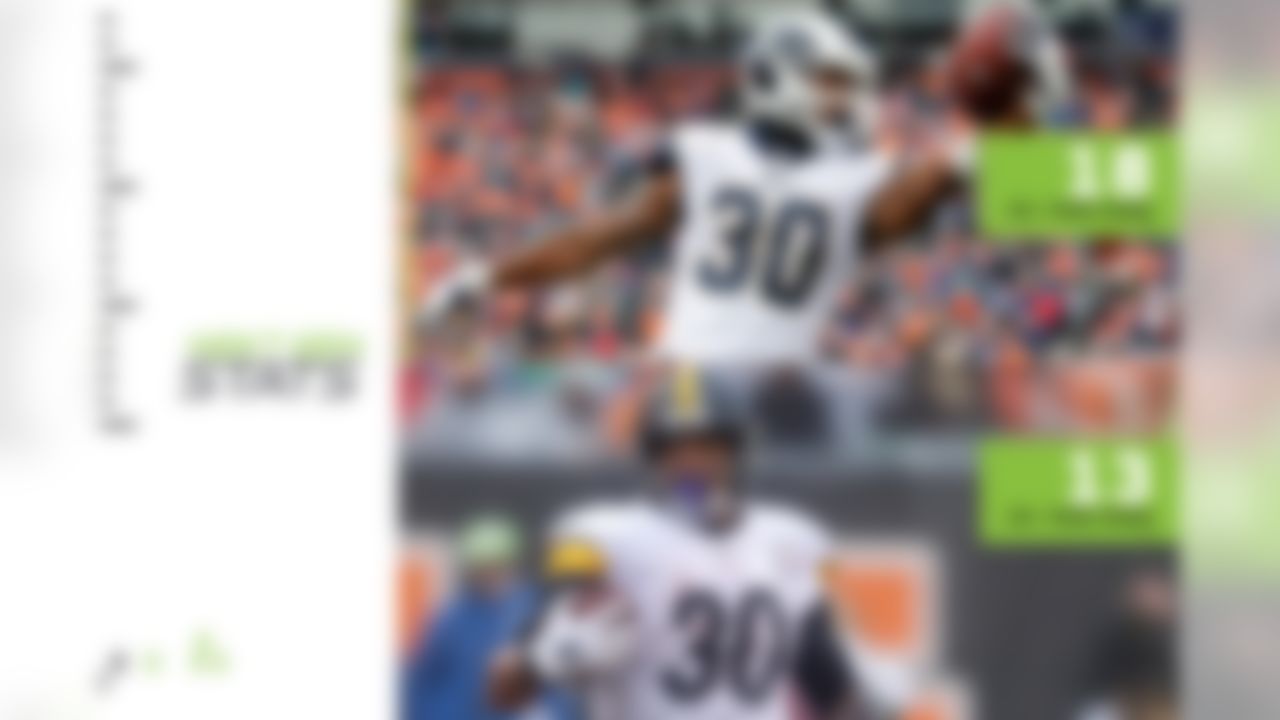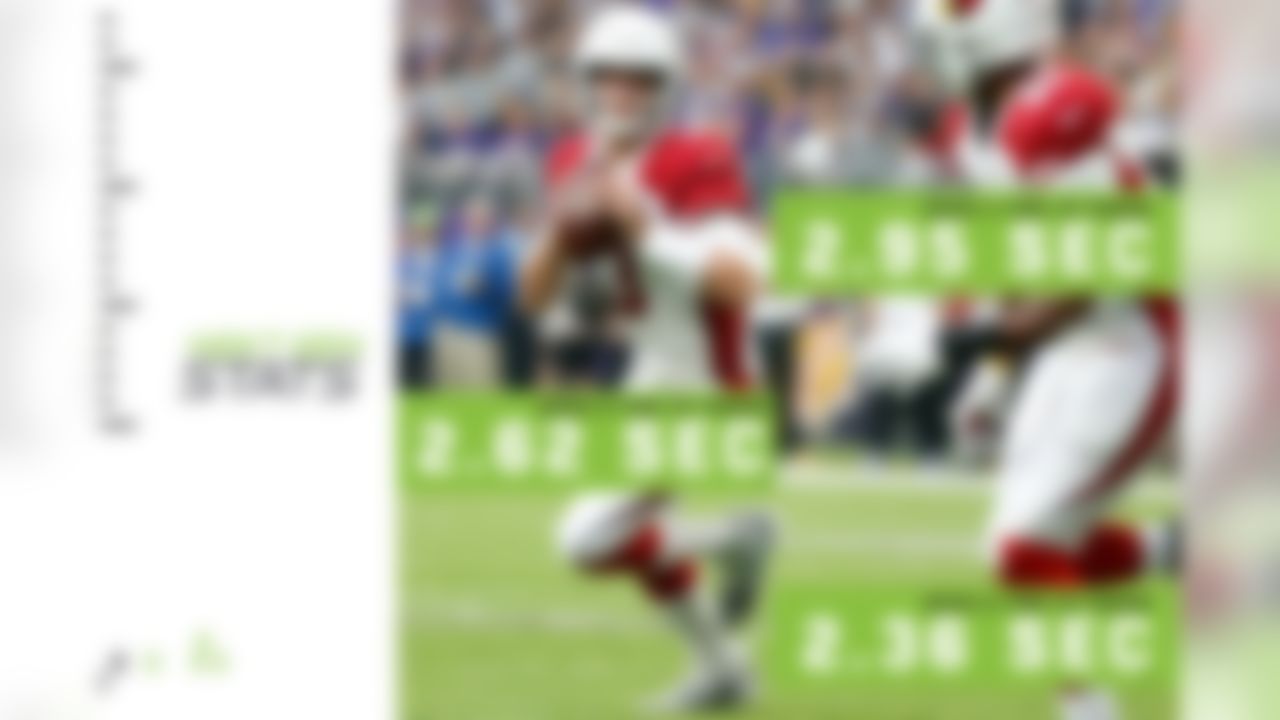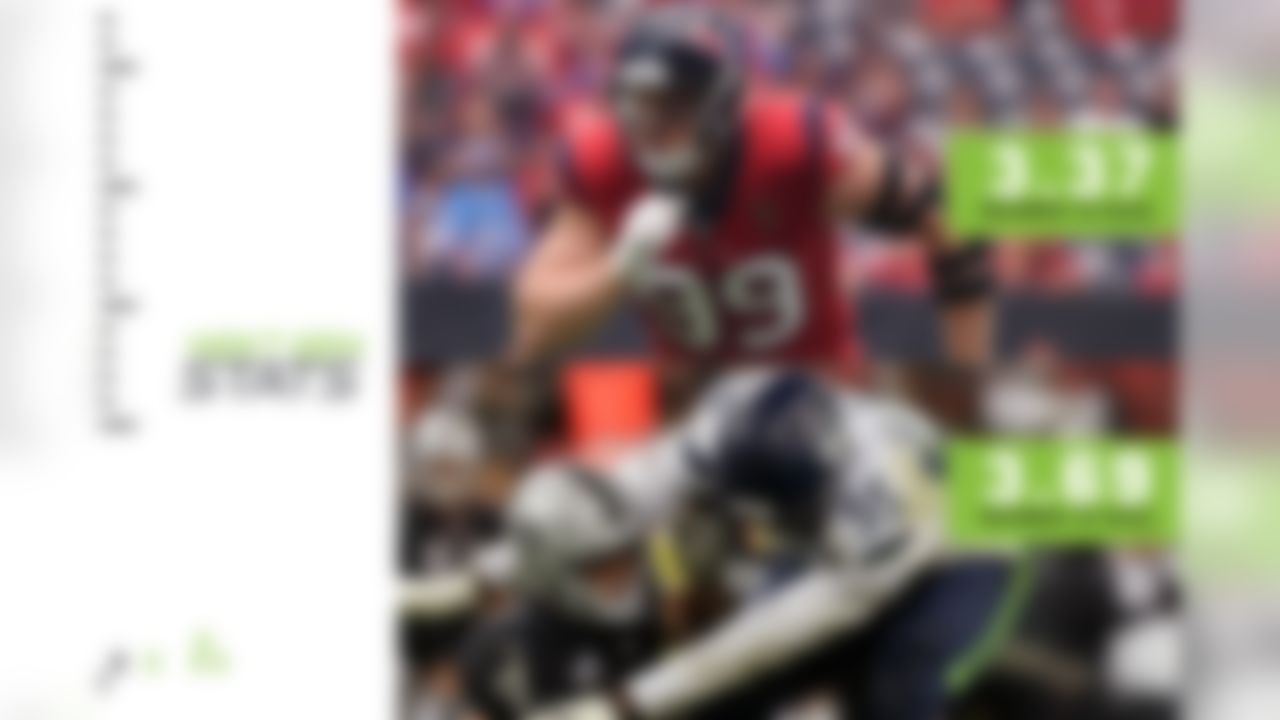NFL Photos | NFL Photography Gallery | NFL.com
Next Gen Stats
Next Gen Stats: Hidden numbers that defined Week 6
Want to see the numbers behind the numbers? Nick Shook dives into a fresh batch of Next Gen Stats and identifies figures that helped shape Week 6.

Two of the NFL's top three rushers -- Ezekiel Elliott and Melvin Gordon -- are facing defenses that stack the box with eight-plus defenders on nearly a quarter of their rushes (Gordon has faced the situation on 29.7 percent of attempts; Elliott has faced it on 23.9 percent), and they're still ripping off big gains. Todd Gurley, on the other hand, is benefiting from defenses that are terrified of getting beaten in the passing game, with Gurley rushing against loaded boxes on just 10.1 percent of his 129 attempts.
The most remarkable nugget gleaned from these comparisons, though, is the production of James Conner. The Steelers back has faced boxes with eight-plus defenders on 38.8 percent of his 103 attempts, second-most in the league among backs with 60 or more carries (behind Baltimore's Alex Collins). Conner is in the top five in rushes of 10-plus yards with 13 and is tied for the highest rush efficiency among that group of five.

Philip Rivers and Tyrell Williams hooked up for a pair of absurd completions in the Chargers' rout of the Browns, delivering what amounted to a death blow to Cleveland's hopes of an upset. First, Rivers dropped back and quickly recognized Cleveland rolling from a pre-snap single-high safety look to a Cover 2. Running down the seam, Williams split the deep defensive backs and caught a perfectly placed pass. Rivers did so under pressure, with just 1.8 yards of separation between him and the nearest rusher. The second catch was no biggie -- just a deep touchdown pass hauled in between three defenders and wrestled out of the hands of one. Both ended up in the top 20 for least likely completions of the season through six weeks. For Week 6 individually, they were the second- and fourth-least likely passes to be completed. Though the touchdown pass was caught amid disadvantageous circumstances, the setup pass -- Rivers' 44-yard strike to Williams -- was the more difficult completion.

Speaking of Rivers, while his draft classmate and former trade counterpart Eli Manning slides toward the end of his playing days, the Chargers quarterback is playing some of his best ball. Rivers is crushing it in several categories, benefitting from a sneakily talented receiving corps, an offensive line that is improving with each week and a big-threat running back. He's the only quarterback in the NFL to have a 100-plus passer rating under pressure and when throwing into tight windows (less than 1 yard of target separation). He's fifth in the league on quick throws (less than 2.5 seconds) and eighth on deep passes (20-plus yards downfield). Read that again. That's a multi-level -- no, an every-level -- blanket coverage of excellence. Maybe it's all that Southern California sun.

After spending the first five weeks of the season as the worst pass-blocking team in the NFL, the Arizona Cardinals enjoyed minor improvement. The Cardinals landed at 18th in the league in Week 6 in pass blocking, per Pro Football Focus, and recorded a middling pressure rate, which isn't great but is much better than the established low standard. A common solution for dealing with a bad line is instituting a shorter, quicker passing game, and the Cardinals were no different.
Josh Rosen's time to throw has dropped by close to a third of a second in each of the last three weeks, from 2.95 seconds, to 2.62 seconds, to 2.36 seconds. It worked from Week 4 to Week 5, dropping Rosen's total pressures from 14 to eight, and that number stabilized in Week 6. But Rosen was sacked four times, the most of any of his outings in his short career. The lesson: Arizona's woes aren't solved —- but they might be on the right track.

Through six weeks, 14 players have five or more sacks in the NFL. The league leader (well, tied for the lead) is no surprise: J.J. Watt. It's not earth-moving that Watt is recording the fastest average sack, at 3.37 seconds per QB takedown, among those with five or more sacks. But where things get fun is below Watt, where Seattle's Frank Clark resides with a per-sack average time of 3.69 seconds. Clark is ahead of former sack champion Chandler Jones, pass-rushing phenom Myles Garrett and a fellow named Khalil Mack. That kind of company is rare, and it sheds light on Seahawks general manager John Schneider's thought process when turning over the old (Michael Bennett and, due to injury, Cliff Avril) for the new (Clark).

The Bengals were slowed by an uncharacteristic game that ended in a loss to the rival Steelers. A team that entered Week 6 second in the NFL in QB pressure rate registered just seven pressures against Ben Roethlisberger, who was below the week's average in time to throw, meaning this was a case of not generating pressure. But maybe it was a bad week. The Bengals will have to hope that's the case when approaching the Chiefs, who feature a budding star who isn't handled base pressure very well. Patrick Mahomes has been pressured less on average in the last three games, but his numbers have gotten significantly worse. He's completed just 40.7 percent of his passes, posted a 1:2 TD-to-INT ratio and a 36.3 passer rating. He's also thrown all four of his interceptions against either three or four pass rushers. Cincinnati blitzes just slightly above league average, at a rate of 27.9 percent, meaning the Bengals can pressure with base rushers. Trouble could be on the way for Mahomes.

Philadelphia seems to be on track again, and Carson Wentz is working back toward his 2017 form. A key to that is who he's targeting. Wentz made a living squeezing throws into tight windows last season, but he's doing the opposite in 2018, going from last in average target separation to first. He has the third-lowest tight-window throw percentage (11.4), and his open-throw percentage has jumped nearly 20 percentage points, from 34.1 to 53.2. The question remains: why? Wentz is throwing shorter passes, for one. He's gone from 9.9 air yards per attempt (second-highest in the NFL) in 2017 to 7.7 (25th in the league) this season. The shorter, more open passes have boosted his completion percentage by more than 8 percentage points compared where he was after four games in '17, and it's padded all his stats relative to that span, with higher passing yards per game, a better TD-to-INT ratio and a passer rating north of 104. Less risk is turning out to be more gain for the defending champions.












